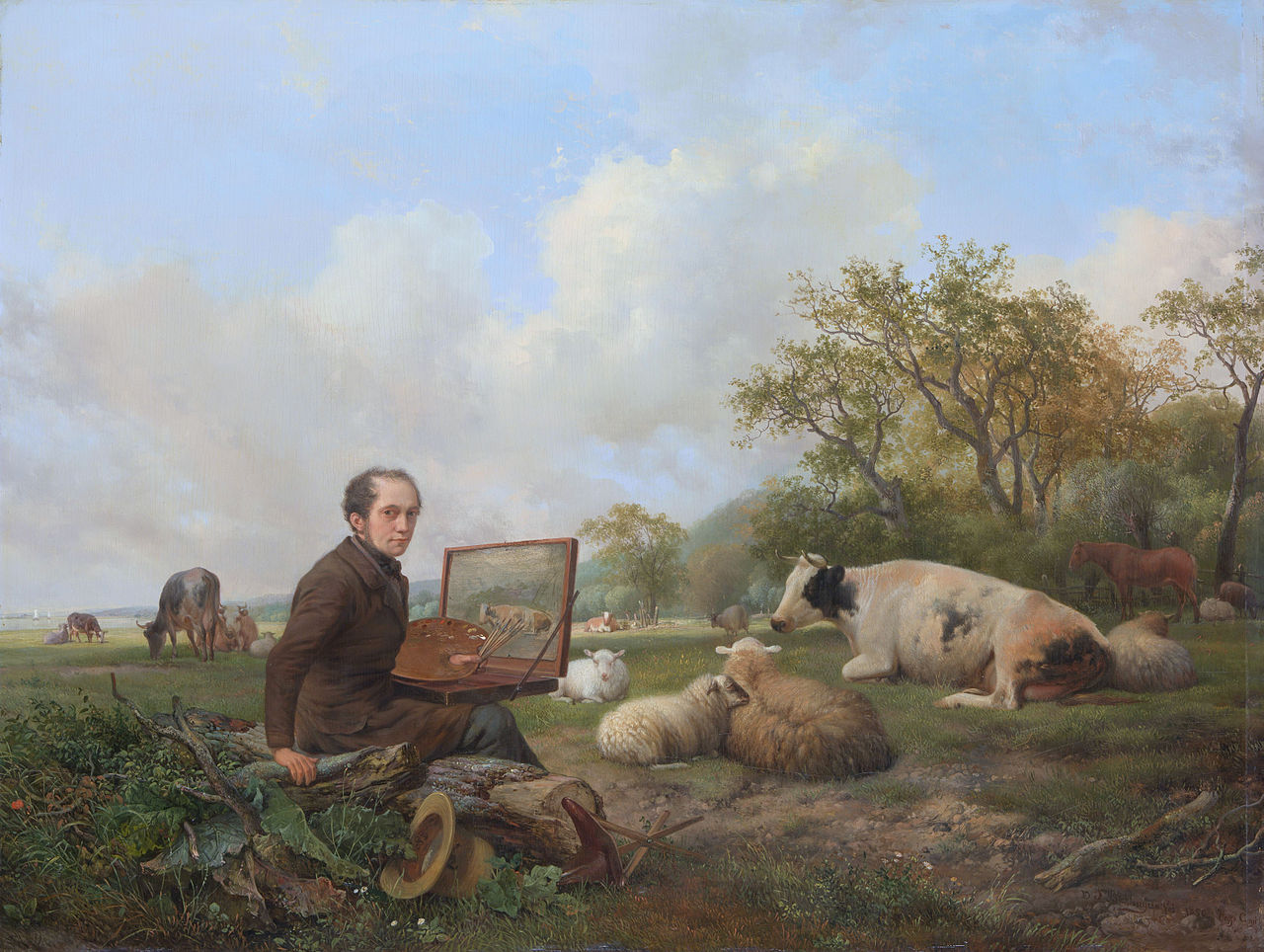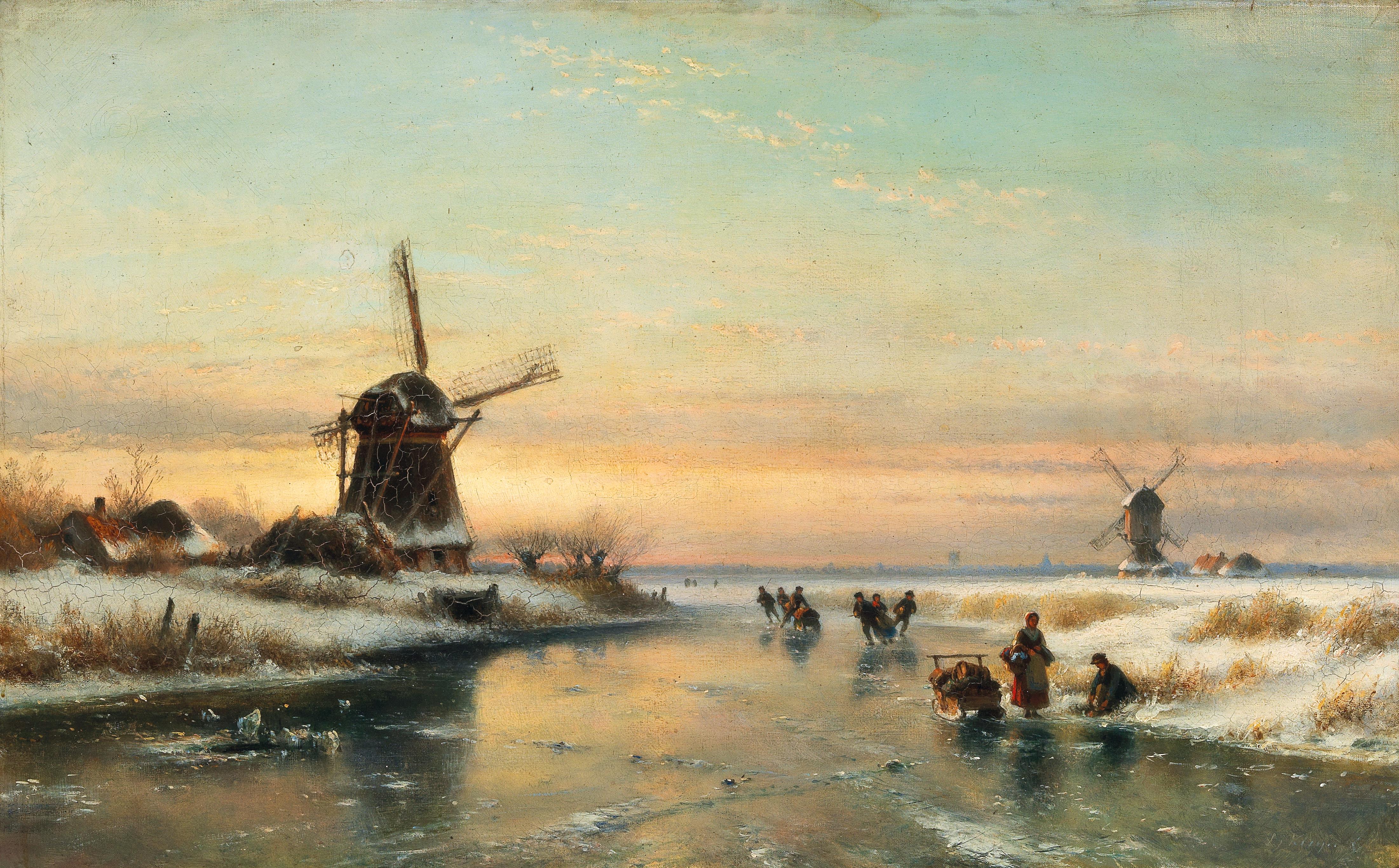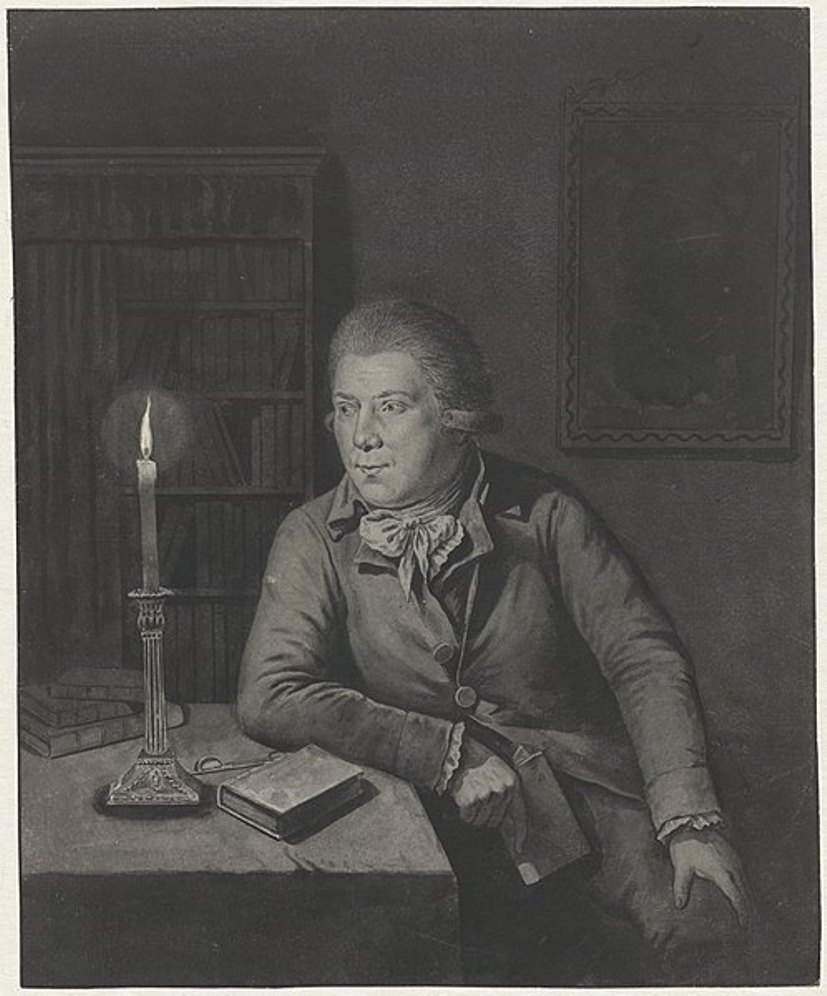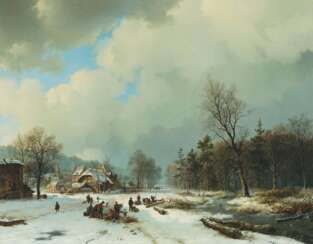winter landscape dutch painting

Hendrikus van de Sande Bakhuyzen was a Dutch landscape painter and teacher.
Bakhuyzen studied at The Hague Academy of Art. He is known for his romantic pastoral scenes, especially paintings of livestock, with detailed landscapes.
In 1822 he became a member of the Royal Academy of Arts in Amsterdam and a member of the board of the Academy of Arts in The Hague. He was later elected director of the Hague Academy. Hendrikus Bakhuyzen made a significant contribution to the Romantic period in Dutch art through his work and activities, raising many talented students and followers who founded the artistic movement known as the Hague School.
His children were also very talented: son Julius van de Sande Bakhuyzen (1835-1925) became a renowned landscape painter; daughter Gerardine Jacob van de Sande Bakhuyzen (1826-1895) became a still life painter; son Henrik Gerard van de Sande Bakhuyzen (1838-1923) became a prominent astronomer, member of the Royal Netherlands Academy of Arts and Sciences and director of the Leiden Observatory; son Ernest-Fredrich van de Sande Bakhuyzen was also an astronomer at the Leiden Observatory.

Andreas Schelfhout was a distinguished Dutch painter, etcher, and lithographer, celebrated for his exquisite landscape paintings. Born and based in The Hague, Schelfhout initially trained as a gilder and framemaker before apprenticing to a decorative painter between 1811 and 1814. This period marked the beginning of his journey into landscape painting, with his works being exhibited from 1815 onwards. Andreas Schelfhout's artistry is deeply rooted in the Romantic movement, with his Dutch winter scenes and frozen canals featuring skaters becoming particularly renowned during his lifetime. These works, showcasing a meticulous attention to detail and atmospheric quality, cemented his status as one of the most influential landscape artists of the 19th century.
A notable aspect of Andreas Schelfhout's career was his impact on other artists. He provided training to many painters who would later gain fame in their own right, such as Johan Jongkind, a forerunner of the Impressionists, and Charles Leickert. His advocacy for the use of watercolour in en plein air sketching significantly influenced his students and contemporaries, particularly enhancing the techniques of Jongkind, Jan Hendrik Weissenbruch, and Willem Roelofs.
Andreas Schelfhout's legacy is not only reflected in his influential teaching but also in the breadth of his creations. His works include not just winter scenes but also seascapes and landscapes depicting various aspects of Dutch scenery. His paintings often evoke a nostalgic longing for the past, a characteristic trait of the Romantic style, with elements like the ruins of castles or chapels adding a historical dimension to the landscapes.
Several of Andreas Schelfhout's masterpieces are displayed in prominent museums and galleries, evidencing his significant contribution to the art world. His works can be found in the Rijksmuseum in Amsterdam, the Museum Boymans-van Beuningen in Rotterdam, the Dordrechts Museum in Dordrecht, the Teylers Museum in Haarlem, and the National Gallery in London, among others.
Andreas Schelfhout was not just an artist; he was a pivotal figure in the Dutch Romantic landscape painting scene. His influence extended beyond his own works to shape the styles and techniques of future generations of artists. For collectors and experts in art and antiques, Schelfhout's works represent a significant era in art history, embodying the essence of Romanticism in Dutch landscape painting.
For those interested in staying informed about new product sales and auction events related to Andreas Schelfhout, signing up for updates is highly recommended. This subscription ensures that enthusiasts and collectors are always in the know regarding the latest developments and opportunities related to Schelfhout's artistry.


Lodewijk Johannes Kleijn was a Dutch lithographer, printmaker and landscape painter who worked in oil and watercolour.


Fredrik Marinus Kruseman was a Dutch painter who specialized in Romantic style landscapes. He received his first drawing lessons from Jan Reekers and attended the Vocational School in Haarlem from 1832 to 1833. That year, he began to study painting with Nicolaas Johannes Roosenboom and, in 1835, moved to the Gooi, where he took advanced studies with Jan van Ravenswaay. He also studied briefly with the landscape painter, Barend Cornelis Koekkoek. In his output of approximately 300 to 350 paintings, only three still-lifes are known and the rest are landscapes. He also made a large number of drawings.


Fredrik Marinus Kruseman was a Dutch painter who specialized in Romantic style landscapes. He received his first drawing lessons from Jan Reekers and attended the Vocational School in Haarlem from 1832 to 1833. That year, he began to study painting with Nicolaas Johannes Roosenboom and, in 1835, moved to the Gooi, where he took advanced studies with Jan van Ravenswaay. He also studied briefly with the landscape painter, Barend Cornelis Koekkoek. In his output of approximately 300 to 350 paintings, only three still-lifes are known and the rest are landscapes. He also made a large number of drawings.


Andreas Schelfhout was a distinguished Dutch painter, etcher, and lithographer, celebrated for his exquisite landscape paintings. Born and based in The Hague, Schelfhout initially trained as a gilder and framemaker before apprenticing to a decorative painter between 1811 and 1814. This period marked the beginning of his journey into landscape painting, with his works being exhibited from 1815 onwards. Andreas Schelfhout's artistry is deeply rooted in the Romantic movement, with his Dutch winter scenes and frozen canals featuring skaters becoming particularly renowned during his lifetime. These works, showcasing a meticulous attention to detail and atmospheric quality, cemented his status as one of the most influential landscape artists of the 19th century.
A notable aspect of Andreas Schelfhout's career was his impact on other artists. He provided training to many painters who would later gain fame in their own right, such as Johan Jongkind, a forerunner of the Impressionists, and Charles Leickert. His advocacy for the use of watercolour in en plein air sketching significantly influenced his students and contemporaries, particularly enhancing the techniques of Jongkind, Jan Hendrik Weissenbruch, and Willem Roelofs.
Andreas Schelfhout's legacy is not only reflected in his influential teaching but also in the breadth of his creations. His works include not just winter scenes but also seascapes and landscapes depicting various aspects of Dutch scenery. His paintings often evoke a nostalgic longing for the past, a characteristic trait of the Romantic style, with elements like the ruins of castles or chapels adding a historical dimension to the landscapes.
Several of Andreas Schelfhout's masterpieces are displayed in prominent museums and galleries, evidencing his significant contribution to the art world. His works can be found in the Rijksmuseum in Amsterdam, the Museum Boymans-van Beuningen in Rotterdam, the Dordrechts Museum in Dordrecht, the Teylers Museum in Haarlem, and the National Gallery in London, among others.
Andreas Schelfhout was not just an artist; he was a pivotal figure in the Dutch Romantic landscape painting scene. His influence extended beyond his own works to shape the styles and techniques of future generations of artists. For collectors and experts in art and antiques, Schelfhout's works represent a significant era in art history, embodying the essence of Romanticism in Dutch landscape painting.
For those interested in staying informed about new product sales and auction events related to Andreas Schelfhout, signing up for updates is highly recommended. This subscription ensures that enthusiasts and collectors are always in the know regarding the latest developments and opportunities related to Schelfhout's artistry.


Willem Koekkoek was a Dutch painter of the urban landscape.
Following in the family tradition, his father gave all four brothers their first art lessons. Willem also received training as an architect, but practiced that profession for only a short time. It did, however, leave a lasting influence on his choice of subject matter.


Barend Cornelis Koekkoek was a Dutch landscape artist and lithographer.


Andreas Schelfhout was a distinguished Dutch painter, etcher, and lithographer, celebrated for his exquisite landscape paintings. Born and based in The Hague, Schelfhout initially trained as a gilder and framemaker before apprenticing to a decorative painter between 1811 and 1814. This period marked the beginning of his journey into landscape painting, with his works being exhibited from 1815 onwards. Andreas Schelfhout's artistry is deeply rooted in the Romantic movement, with his Dutch winter scenes and frozen canals featuring skaters becoming particularly renowned during his lifetime. These works, showcasing a meticulous attention to detail and atmospheric quality, cemented his status as one of the most influential landscape artists of the 19th century.
A notable aspect of Andreas Schelfhout's career was his impact on other artists. He provided training to many painters who would later gain fame in their own right, such as Johan Jongkind, a forerunner of the Impressionists, and Charles Leickert. His advocacy for the use of watercolour in en plein air sketching significantly influenced his students and contemporaries, particularly enhancing the techniques of Jongkind, Jan Hendrik Weissenbruch, and Willem Roelofs.
Andreas Schelfhout's legacy is not only reflected in his influential teaching but also in the breadth of his creations. His works include not just winter scenes but also seascapes and landscapes depicting various aspects of Dutch scenery. His paintings often evoke a nostalgic longing for the past, a characteristic trait of the Romantic style, with elements like the ruins of castles or chapels adding a historical dimension to the landscapes.
Several of Andreas Schelfhout's masterpieces are displayed in prominent museums and galleries, evidencing his significant contribution to the art world. His works can be found in the Rijksmuseum in Amsterdam, the Museum Boymans-van Beuningen in Rotterdam, the Dordrechts Museum in Dordrecht, the Teylers Museum in Haarlem, and the National Gallery in London, among others.
Andreas Schelfhout was not just an artist; he was a pivotal figure in the Dutch Romantic landscape painting scene. His influence extended beyond his own works to shape the styles and techniques of future generations of artists. For collectors and experts in art and antiques, Schelfhout's works represent a significant era in art history, embodying the essence of Romanticism in Dutch landscape painting.
For those interested in staying informed about new product sales and auction events related to Andreas Schelfhout, signing up for updates is highly recommended. This subscription ensures that enthusiasts and collectors are always in the know regarding the latest developments and opportunities related to Schelfhout's artistry.


Aert van der Neer was a Dutch painter of the Gilded Age.
Van der Neer is considered a pioneer of the night landscape because of his successful solutions to lighting issues in his works. He painted many pictures of winter landscapes, including nighttime fires.


Barent Avercamp was a Dutch painter. He was taught by his uncle Hendrick Avercamp, who was also a painter. Barent primarily painted scenes depicting Netherlands in winter. He was a member of the Guild of Saint Luke, and traveled around the Netherlands including Zwolle and Zutphen for his settings and inspiration.


Andreas Schelfhout was a distinguished Dutch painter, etcher, and lithographer, celebrated for his exquisite landscape paintings. Born and based in The Hague, Schelfhout initially trained as a gilder and framemaker before apprenticing to a decorative painter between 1811 and 1814. This period marked the beginning of his journey into landscape painting, with his works being exhibited from 1815 onwards. Andreas Schelfhout's artistry is deeply rooted in the Romantic movement, with his Dutch winter scenes and frozen canals featuring skaters becoming particularly renowned during his lifetime. These works, showcasing a meticulous attention to detail and atmospheric quality, cemented his status as one of the most influential landscape artists of the 19th century.
A notable aspect of Andreas Schelfhout's career was his impact on other artists. He provided training to many painters who would later gain fame in their own right, such as Johan Jongkind, a forerunner of the Impressionists, and Charles Leickert. His advocacy for the use of watercolour in en plein air sketching significantly influenced his students and contemporaries, particularly enhancing the techniques of Jongkind, Jan Hendrik Weissenbruch, and Willem Roelofs.
Andreas Schelfhout's legacy is not only reflected in his influential teaching but also in the breadth of his creations. His works include not just winter scenes but also seascapes and landscapes depicting various aspects of Dutch scenery. His paintings often evoke a nostalgic longing for the past, a characteristic trait of the Romantic style, with elements like the ruins of castles or chapels adding a historical dimension to the landscapes.
Several of Andreas Schelfhout's masterpieces are displayed in prominent museums and galleries, evidencing his significant contribution to the art world. His works can be found in the Rijksmuseum in Amsterdam, the Museum Boymans-van Beuningen in Rotterdam, the Dordrechts Museum in Dordrecht, the Teylers Museum in Haarlem, and the National Gallery in London, among others.
Andreas Schelfhout was not just an artist; he was a pivotal figure in the Dutch Romantic landscape painting scene. His influence extended beyond his own works to shape the styles and techniques of future generations of artists. For collectors and experts in art and antiques, Schelfhout's works represent a significant era in art history, embodying the essence of Romanticism in Dutch landscape painting.
For those interested in staying informed about new product sales and auction events related to Andreas Schelfhout, signing up for updates is highly recommended. This subscription ensures that enthusiasts and collectors are always in the know regarding the latest developments and opportunities related to Schelfhout's artistry.


Aert van der Neer was a Dutch painter of the Gilded Age.
Van der Neer is considered a pioneer of the night landscape because of his successful solutions to lighting issues in his works. He painted many pictures of winter landscapes, including nighttime fires.


Tina Blau (later Tina Blau-Lang) was an Austrian landscape painter.
Her husband was Heinrich Lang, a painter who specialized in images of horses and battle scenes.


Karel Dujardin was a Dutch painter and printmaker of the Golden Age of Dutch painting.
He studied with Klaas Berchem and Paulus Potter, traveled to Italy, and lived in Lyon. In 1656 he participated in the founding of the Pictura Society in The Hague.
Dujardin painted mostly Italian landscapes, genre scenes, including scenes from rural life, portraits of elegant people and historical paintings.
Many of Dujardin's works are in the Louvre, the Hermitage (St. Petersburg), as well as in Amsterdam, The Hague, Kassel, and Berlin.


Adriaen van de Velde was a Dutch painter, draughtsman and print artist. His favorite subjects were landscapes with animals and genre scenes. He also painted beaches, dunes, forests, winter scenes, portraits in landscapes, as well as mythological and biblical scenes. He belongs to a group of painters referred to as the Dutch Italianate painters, who combined Dutch agricultural landscapes with mythological or Arcadian scenes in Italian settings. His paintings are characterised by their delicate, careful composition and his mastery of lighting effects as well as the human figure.


Hendrick Avercamp was a seminal Dutch painter during the Dutch Golden Age. He is celebrated as one of the earliest landscape painters of the 17th-century Dutch school, specializing in vibrant winter scenes of the Netherlands. His paintings are filled with colorful and lively depictions of people engaging in various activities against the backdrop of the Dutch winter landscape.
Educated by the Danish-born portrait painter Pieter Isaacsz, Hendrick Avercamp's work reflects a strong influence from the Flemish painting tradition, especially evident in the landscapes reminiscent of Pieter Bruegel the Elder. His technique of aerial perspective, where objects in the foreground are painted with richer colors than those in the distance, creates a remarkable impression of depth in his paintings.
Hendrick Avercamp's most ambitious and acclaimed work, 'Winter Landscape with Ice Skaters', painted around 1608, is a detailed panorama of human and animal activities during a harsh winter. This painting, along with others like 'Winter Landscape with a Frozen River and Figures' and 'Winter Landscape with Skates and People Playing Golf', showcase his knack for narrative, capturing various facets of 17th-century Dutch society enjoying the winter season.
Despite being mute and probably deaf, Hendrick Avercamp's keen observation skills are evident in his works, where he intricately portrays diverse classes engaging in various winter activities. He produced about a hundred paintings, many of which can be seen in the Rijksmuseum in Amsterdam and the Mauritshuis in The Hague. His work was also celebrated for its historical quality, providing a glimpse into the life of different societal levels in the Netherlands at that time.
For collectors and enthusiasts of art and antiques, Hendrick Avercamp's paintings offer a fascinating window into the Dutch Golden Age, with their vivid portrayal of life and activities in a winter setting. His works, characterized by meticulous detail and a cheerful narrative, remain an integral part of the conversation in the history of Dutch art.
To stay updated on the latest insights and collections related to Hendrick Avercamp's works, consider subscribing to our updates. Stay informed about new sales, exhibitions, and auction events featuring this master of Dutch winter landscapes.



































































